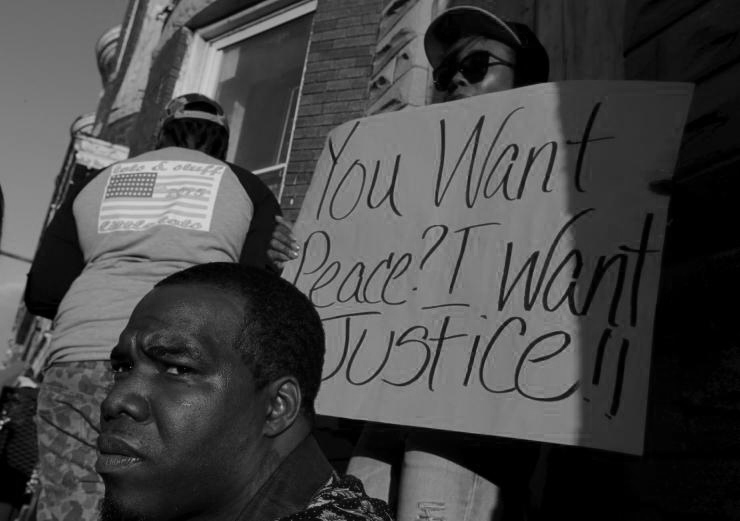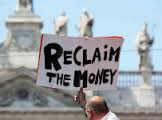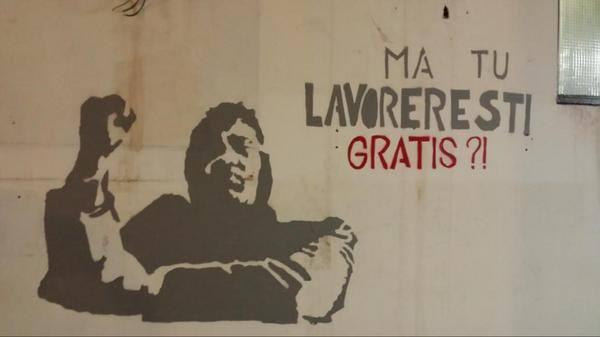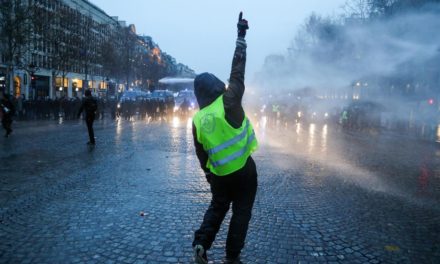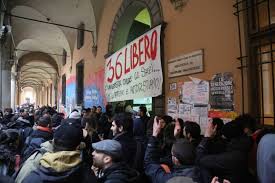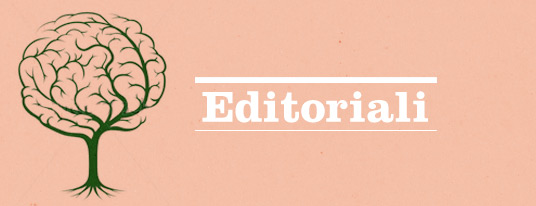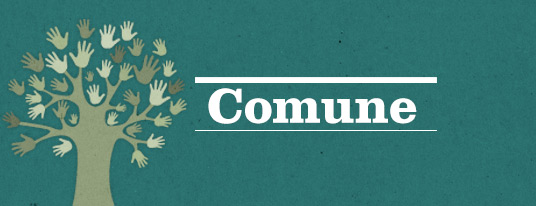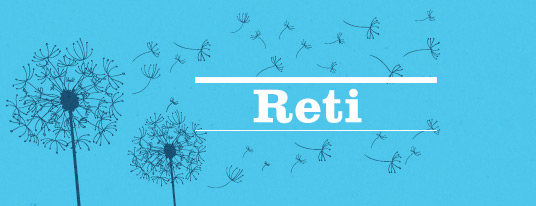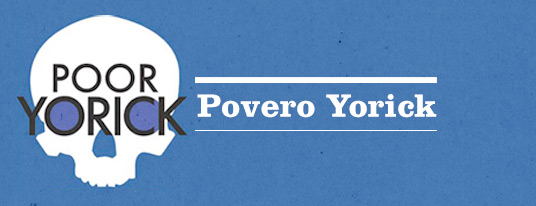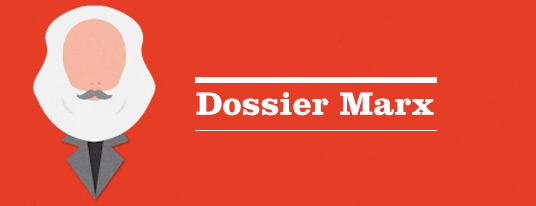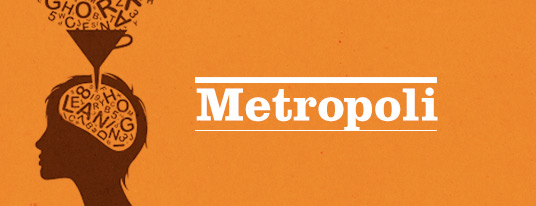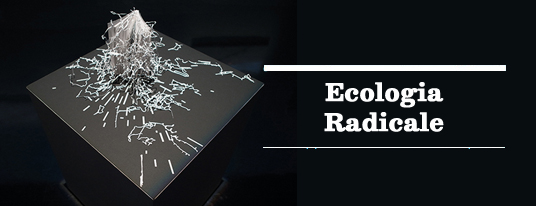by YOUSUF AL-BULUSHI.
In continental Europe it was not easy to understand the campaigns led by King—and, even more difficult, that of the Nation of Islam.
Ferruccio Gambino “Reading Black Reconstruction on the Eve of 1968”
We could have opted for black Al-Qaedas. Y’all terrorize us, we terrorize you…You kill our children randomly, we’re gonna kill your children randomly. But no, we had spirit.
Cornel West, May 18, 2015 interview with The Real News Network
“We cannot let this be a repeat of 1968,” said Baltimore Councilman Brandon Scott. It was Monday April 27, 2015, and West Baltimore resident Freddie Gray had just been laid to rest. The specter of 1968 that Councilman Scott raised on this day was a reference to the riots that broke out in Baltimore and in nearly every major US city following the assassination of Martin Luther King, Jr. on April 4, 1968. But the riots of 1968 following the death of King were arguably part of a broader historical sequence—arguably an age of urban revolt—beginning with the Watts rebellion of 1965 in Los Angeles, stretching all the way to the Parisian banlieues in 2005, Tottenham, England in 2011, and now Baltimore in 20151. While King was assassinated for being a prominent political activist and a critic of American imperialism, Freddie Gray, Trayvon Martin, Tanisha Anderson, Michael Brown and the countless other martyrs whose deaths have sparked a growing movement in the United States were all arguably killed not because of political or legal transgressions, but merely because of the color of their skin.
Gray was arrested in his neighborhood of Sandtown on April 12 after daring to make eye contact with the police before attempting to run away. He was severely injured while under officer custody, falling into a coma soon after his detention, and dying a week later. The weeks following his death have seen a number of protests in the city, demanding that police be held accountable for their actions. The protests were immediately identifiable as part of the larger Black Lives Matter movement that began when Trayvon Martin’s killer, George Zimmerman, was acquitted in July 2013. This movement received its name from three black women who work with a variety of radical organizations. Alicia Garza, one of the women who launched the twitter hashtag, explains: “It was a response to the anti-Black racism that permeates our society and also, unfortunately, our movements.”2
Black Lives Matter in the Global Cycle of Struggles
The rebellion in Baltimore, as Ruth Wilson Gilmore argues convincingly, was an anti-austerity3 uprising. Beneath the din of media coverage focused on the spectacle of “violent” property destruction, there is no denying that the broader conjuncture of economic crisis and neoliberal restructuring has shaped the Black Lives Matter movement. Taking a global perspective on the decidedly urban rebellions over the past 7 years, The Invisible Committee claims “We are not contemporaneous with scattered revolts, but with an unparalleled global wave of uprisings that intercommunicate imperceptibly.”4
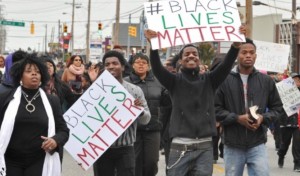 The message that Baltimore and the broader Black Lives Matter movement transmits to these global struggles must certainly be grasped in part through highlighting, as Alicia Garza argues, the pervasive nature of anti-black racism not simply at the most visible level of state institutions such as the police, but also within our movements. What is more, the Baltimore uprising brings to the fore a certain conceptual impasse between neoliberalism on the one hand and the persistence of a racialized gratuitous violence, between differential inclusion and surplus exclusion. Only by analyzing and grappling with the divisive and global nature of anti-blackness, firmly implanted in struggles from Libya to Greece5 in this unraveling sequence of struggle, will we learn the lessons of Baltimore. As Ferruccio Gambino admits, recognizing and comprehending the specificity of black struggles has often proved elusive6. Part of the problem, ironically, lies in our unwillingness to confront racism through anything but the spectacular. Just as the media became interested in Freddie Gray only after property destruction began, so too does our movements haltingly recognize racism only through the face of spectacular incidents of police violence. “Most theories of white supremacy,” argue Steve Martinot and Jared Sexton, “seek to plumb the depths of its excessiveness, beyond the ordinary; they miss the fact that racism is a mundane affair.”7
The message that Baltimore and the broader Black Lives Matter movement transmits to these global struggles must certainly be grasped in part through highlighting, as Alicia Garza argues, the pervasive nature of anti-black racism not simply at the most visible level of state institutions such as the police, but also within our movements. What is more, the Baltimore uprising brings to the fore a certain conceptual impasse between neoliberalism on the one hand and the persistence of a racialized gratuitous violence, between differential inclusion and surplus exclusion. Only by analyzing and grappling with the divisive and global nature of anti-blackness, firmly implanted in struggles from Libya to Greece5 in this unraveling sequence of struggle, will we learn the lessons of Baltimore. As Ferruccio Gambino admits, recognizing and comprehending the specificity of black struggles has often proved elusive6. Part of the problem, ironically, lies in our unwillingness to confront racism through anything but the spectacular. Just as the media became interested in Freddie Gray only after property destruction began, so too does our movements haltingly recognize racism only through the face of spectacular incidents of police violence. “Most theories of white supremacy,” argue Steve Martinot and Jared Sexton, “seek to plumb the depths of its excessiveness, beyond the ordinary; they miss the fact that racism is a mundane affair.”7
Complicating matters in Baltimore is the fact that the city has a large number of black officials who occupy relative positions of power, from city government to the police department. How to explain, as in post-apartheid South Africa, the persistence of anti-blackness as a governing logic in the context of being governed by a black representative class? Here the specificity of leadership beyond representation must be grappled with. Yes, a panoply of elected officials, pastors and self-appointed “community representatives” have attempted to placate the uprising while demanding a “return” to a supposedly zero-level peace. But other structures of leadership—most notably Baltimore United for Change—intervened in a productive fashion, channeling the efforts of protestors and ensuring that their efforts would endure through existing institutions and new formations. Baltimore is fortunate to have a number of organizations that provide the movement with a more steadfast infrastructure. These groups include Heber Brown’s Pleasant Hope Baptist Church, the grassroots Real News Network, and the best radical bookstore in the United States in Red Emma’s. Most prominent among these local institutions has been the Leaders of a Beautiful Struggle, whose name itself reflects the inescapability of leadership in the evacuated zone between horizontality and forms of state power. But as Latin American and African countries have already demonstrated since the mid-1990s, and as Syriza and now Podemos continue to prove, the dialectic between movement and state power, between constituent and constituted powers, cannot be side-stepped or ignored.
Organizing in Baltimore
The Black Lives Matter movement has pinballed from Florida to Ferguson, from Oakland to Seattle, and New York to Ohio. After Gray’s death at the hands of the police in Baltimore the movement came to the state of Maryland in a big way. Protests were organized by a variety of organizations, and began after Gray had fallen into a coma but before he had passed away. These groups included the Baltimore People’s Power Assembly, Leaders of a Beautiful Struggle, Baltimore Bloc, the Southern Christian Leadership Conference, a coalition of area college students that formed a new chapter of the Student Non-Violent Coordinating Committee, Casa de Maryland, members of the Pleasant Hope Baptist Church in alliance with other progressive church congregations, and the family members of another Baltimore police brutality victim in the Tyrone West Coalition, among many others.
A number of protestors came from neighboring Washington, D.C. and Philadelphia, and some came from even further afar to join the new epicenter of struggle that Baltimore had become. In response to and appreciation for this growing presence of supporters of Freddie Gray, local organizers issued a call-out, welcoming those coming in from out of town but asking them to defer to local grassroots structures of organizing that would have to deal with the consequences of protest actions even after they inevitably waned. This was not a demand for pacification, or to work within existing structures of power. Rather, it was an attempt to offer structures of accountability by grounding the movement in local affinities. Often our mobilizations are fruitfully sporadic but also too open to co-optation by (government) provocateurs pushing protestors to do things that could easily justify a heavy police crackdown. These open and unaccountable forms of protest can endanger those whose lives are most affected by the police. In this sense, Baltimore was productively able to seize on a moment by channeling the contributions from a range of protestors—whether they were suburban middle class white families, anarchist students, or militant black nationalists—in a manner that would feed the enduring efforts of local institutions.
These local groups soon banded together to form Baltimore United for Change8, a coalition representing a variety of Baltimore organizations who had already been working on issues of police brutality and mass incarceration in the city, and who shared a commitment to build on the efforts of the protests “once the cameras disappeared.”
These cameras, largely absent in the initial week of protests, descended on the city en masse on Monday April 27, when that Councilman Scott, along with Mayor Stephanie Rawlings Blake and Governor Hogan all issued concerned declarations about the specter of 1968 looming over the city. While the media spread vicious rumors about a student-led purge9 — in line with the Hollywood film by that name —and a gang truce that would supposedly target police with violence10 , a number of stores in West Baltimore were looted and a CVS pharmacy was set on fire. Another building—a senior center still under construction in East Baltimore—went up in flames, adding fuel to the media’s desire for the spectacular, even though it would be stated repeatedly by the mayor that this fire was apparently disconnected from the protests.
The initial looting that occurred on April 27 largely revolved around the Mondawmin Mall. Mondawmin opened in 1956, just after the US Supreme Court had outlawed school segregation. Nonetheless, it originally included stores that refused to serve African Americans. This policy wasn’t very effective, however, as white clientele soon fled for the suburbs in the face of a successful movement to end the legal segregation of American cities. White America would maintain its exclusive privileges through a variety of insurgent spatial planning techniques such as redlining, restrictive covenants, blockbusting and intentionally white suburbanization.
Redlining was a Keynesian-endorsed practice the federal government used in the aftermath of the Great Depression as a way of mapping all of America’s cities to indicate which neighborhoods were considered safe and stable for economic investment, thus indicating what areas the federal government would offer to subsidize bank loans for mortgages, guaranteeing them through the newly formed Federal Housing Administration. Red lines were drawn around the most unfavorable neighborhoods using a metric that included race as a decisive factor determining whether a neighborhood qualified as worthy of investment. Restrictive covenants were private agreements entered into by neighborhood associations intended to keep Jews, African Americans, Latin@s and other supposedly undesirable people of color from being able to move into their neighborhood. Blockbusting was a practice adopted by real estate investors whereby rumors were often spread in a white neighborhood or ‘block’ of the city that black families were moving into the neighborhood and that all sorts of social ills would follow. White homeowners were encouraged to sell homes for a fraction of their worth in order to move to the suburbs, while investors turned around and sold these homes to black families at double or triple the price they paid for them. If these new black families could not afford the payments, investors repossessed the homes and re-sold them at exorbitant rates to the next black family willing to take a risk in order to move in to a previously white neighborhood where housing stock and access to city services was thought to be better. When restrictive covenants were eventually overturned by the Supreme Court as illegal in 1948, and desegregation became a legal reality over the next twenty years as a result of a variety of movements, white suburbanization became the answer to the question of how to maintain white privilege. As a result of these policies, schools, city governments, and businesses like those at Mondawmin located within the city would suffer tremendous decline and abandonment. When the 2008 housing crisis rocked the United States, Baltimore already had one of the highest rates of vacant buildings in the country. It would get worse, again affecting black homeowners with a vengeance. Even wealthy blacks were three times more likely to receive the risky subprime loans than poor whites. Indeed, “whoever says ‘subprime debtor’ says black as well.”11
All these patterns ensured that, among cities larger than 250,000 people in the US, only Detroit would be blacker than Baltimore. While legalized desegregation has been in place for more than half a century, American cities remain productive of apartheid geographies. Freddie Gray’s neighborhood of Sandtown is 95% black, according to the US census. Even official statistics betray a level of “premature death”12 that is astounding: a poverty rate of 31%, a 1 in 5 juvenile arrest rate, infant mortality rates 3.5 times the national average, incarceration rates 6 times the national average, and a life expectancy that is 13 years shorter than the average American.
New forms of leadership
Baltimore United for Change and the Leaders of a Beautiful Struggle promise to continue pushing for legislative changes and to contest state power on a local level in the upcoming elections. The question facing these movements will be how to re-envision leadership in such a way that does not repeat the mistakes of the last round of movement co-optation into the municipal elections of a black middle class beginning in the 1970s. Going forward, we must remember Adolph Reed’s prescient insight that “the kind of city most likely to be governed by a black regime is also the kind of city most likely to suffer the regressive effects of suburbanization and least likely to have the option of mitigating them by means of expanding municipal boundaries.”13
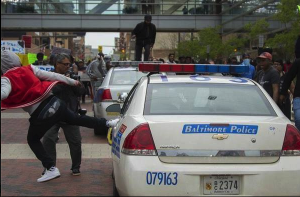 In the face of unceasing forms of state violence targeting racialized populations in the US and around the world, the persistence of innovative forms of leadership—“Ella Baker-style,” as Pastor Heber Brown says—coupled with, as Cornel West notes, spiritual rather than vindictive mobilizations, has provided a consistency to the Black Radical Tradition. The common love that we all experienced in Baltimore’s streets during the uprising—taking over the streets at will in marches that stopped traffic to the delight of drivers who got out of cars and promptly joined the gatherings, challenging the week-long night-time curfew imposed by the national guard, and realigning ourselves with youth dirt bikers named the 12 O’Clock Boys who popped block-long wheelies of joy alongside the marches in defiance of being labeled ‘thugs’ by our state ‘representatives’—is indicative of that tradition.
In the face of unceasing forms of state violence targeting racialized populations in the US and around the world, the persistence of innovative forms of leadership—“Ella Baker-style,” as Pastor Heber Brown says—coupled with, as Cornel West notes, spiritual rather than vindictive mobilizations, has provided a consistency to the Black Radical Tradition. The common love that we all experienced in Baltimore’s streets during the uprising—taking over the streets at will in marches that stopped traffic to the delight of drivers who got out of cars and promptly joined the gatherings, challenging the week-long night-time curfew imposed by the national guard, and realigning ourselves with youth dirt bikers named the 12 O’Clock Boys who popped block-long wheelies of joy alongside the marches in defiance of being labeled ‘thugs’ by our state ‘representatives’—is indicative of that tradition.
Perhaps by taking our cue from the queer women spearheading the national movement, we can build on the limitations of past struggles that too often bracketed a spirituality oriented towards the ethos that “another world is possible.” In so doing we might also refuse the absolute urgency of instrumental struggle objectives in the name of recognizing a broader politics of love. “One of the criticisms often levied at the Panthers,” reflects Baltimore icon and former Black Panther leader Eddie Conway, “is that we lacked a spiritual base to our movement. On the surface this is true, however I always took to heart the quote by Che Guevara that says that the true revolutionary is guided by great feelings of love. We were a revolutionary organization in the throes of removing the shackles of a few hundred years of Western influence and dominance, but at the core was a righteous love for our communities and people. Love, like most emotions, is spirit-based; it possesses us and bend us to its will.”14 If Baltimore is to become part of “a movement, not a moment,” as local organizers keep reminding us, we must prove ourselves capable of being affected and bent by the profound collective love produced in the inspiring but too-often fleeting moment of rebellion.
See, for example: Duda, John (2008) “Naturalizing Urban Counterinsurgency” Critical Planning. Vol. 15 and Al-Bulushi, Yousuf (2012) “Learning from Urban Revolt: From Watts to the Banlieues” City: Analysis of Urban Trends, Culture, Theory, Policy, Action. Vol. 16, No. 1-2: 34-56. ↩
Garza, Alicia. (2014) “A Herstory of the #BlackLivesMatter Movement.” http://thefeministwire.com/2014/10/blacklivesmatter-2/ ↩
Vulliamy, Ed. (2015) “The Rebellion in Baltimore is an uprising against austerity, claims top US academic,” http://www.theguardian.com/usnews/2015/may/02/baltimore-rebellion-is-uprising-against-austerity-freddie-gray ↩
The Invisible Committee. (2015) To Our Friends. Cambridge: Semiotext(e). P. 14. ↩
In the “Libyan Spring” the anti-Ghaddafi movement was also a virulently anti-black one, targeting dark-skinned Libyans and migrants at will, killing them, rounding them up into internment camps, and sometimes destroying entire villages where they lived. See, for example, Bill Quigley (2013) “US and NATO-supported Libyan ‘Rebels’ Continue Persecution of Blacks in Libya,” http://www.blackagendareport.com/content/us-and-nato-supported-libyan-rebels-continue-persecution-blacks-libya In Greece, the fascist Golden Dawn movement that has grown rapidly along with the deepening economic crisis targets people randomly by race, encouraging Greek citizens to “say something if you see something” in the streets. The movement against austerity in Greece has been extremely slow and hesitant to directly confront this growing issue, preferring to focus on ‘economic’ issues while forming a coalition with these same right-wing racist parties in government. ↩
Gambino, Ferrucio. (2013) “Reading Black Reconstruction on the Eve of 1968,”The South Atlantic Quarterly. Vol. 112, No. 3: 529-535. ↩
Martinot, Steve and Jared Sexton. (2003) “The Avante-Garde of White Supremacy,” Social Identities. Vol. 9, No. 2: 169-181. ↩
http://bmoreunited.org ↩
In James De Monaco’s 2013 film The Purge, a post-economic crisis America has solved its prior problems through a new totalitarian government. Once a year, however, the new government offers the country one night of lawlessness, a chance to supposedly “purge” the society of all its tendencies to commit crime. On this night, all laws are abolished and people roam the streets with impunity looking for fights to pick or stores to rob. The meaning of purge is somewhat ambiguous, however, as it isn’t clear if it is intended to purge society of wrong doing, to purge the country of the political dissent, or even of the wealthy. The vicious rumor following Freddie Gray’s funeral, and once the first clashes with police began, was that Baltimore students were planning a similarly ambiguous day of “purge” throughout the city. ↩
Not only did the rumors of gang plans to target the police with violence prove false, but many members of the Bloods, the Crips and the Black Guerilla Family gave interviews with media in which they expressed a desire for the protestors to stop acts of property destruction and to instead channel their efforts into uniting their own communities for justice. ↩
Moten, Fred. (2013) “The Subprime and the beautiful,” African Identities. Vol. 11, No. 2: 237-245. ↩
Gilmore, Ruth Wilson. (2002) “Fatal Couplings of Power and Difference: Notes on Racism and Geography,” The Professional Geographer. Vol. 54, No. 1: 15-24. ↩
Reed, Adolph. (1998) Stirrings in the Jug: Black Politics in the Post-Segregation Era. Minneapolis: University of Minnesota Press. ↩
Conway, Marshall “Eddie”. (2011) Marshall Law: The Life and Times of A Baltimore Black Panther. Oakland: AK Press. P. 191. ↩

